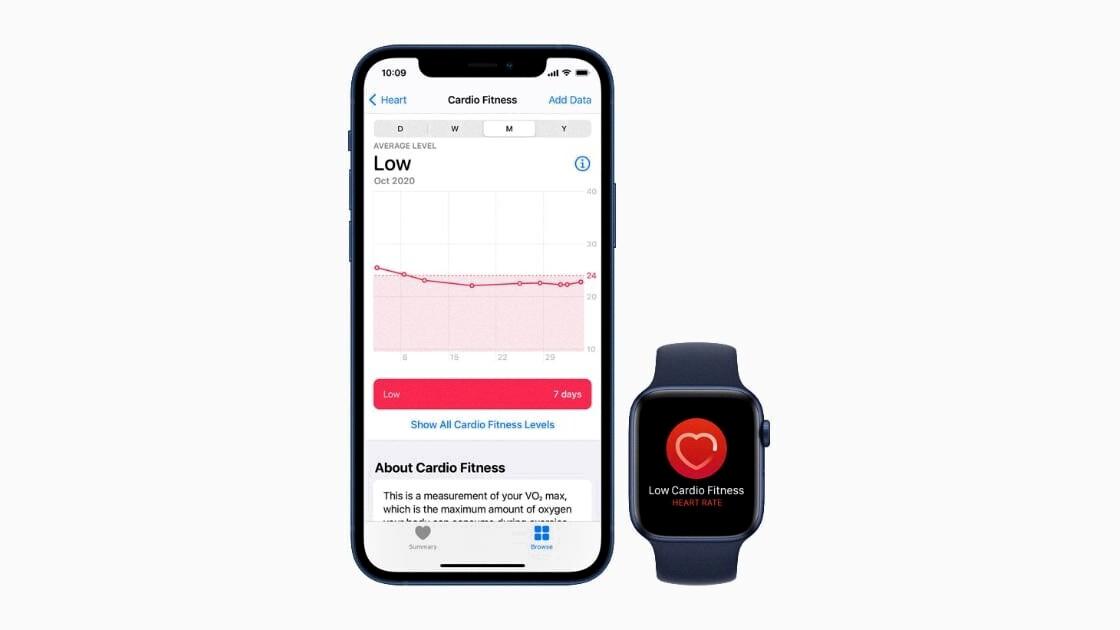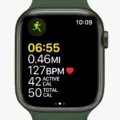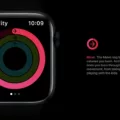
Fitness tracking has become more important than ever, and the Apple Watch has emerged as a pivotal tool for enthusiasts aiming to monitor and enhance their physical well-being. In this pursuit, the VO2 max score is a critical metric representing the utmost volume of oxygen your body can utilize during intense activities per minute.
This score is paramount in assessing aerobic fitness levels, essentially serving as a compass for tailoring training regimens. However, some users have encountered a perplexing phenomenon: sudden declines in their VO2 max readings, sparking curiosity and concern.
The VO2 max score’s significance in the fitness world cannot be overstated. It provides a window into one’s cardio fitness, offering insights instrumental in optimizing workout strategies.
The VO2 max is meticulously computed on the Apple Watch, leveraging an intricate algorithm that combines heart rate and motion data. This process involves the watch’s sophisticated sensors capturing heart rate fluctuations while its accelerometer gauges movement intensity, painting a comprehensive picture of one’s fitness.
Understanding VO2 Max
It’s crucial to grasp what VO2 max is and why it is a vital indicator of your aerobic fitness.
VO2 max, short for Volume of Oxygen Max, quantifies the maximum volume of oxygen your body can consume per minute relative to body weight. It measures your cardiovascular and respiratory system’s efficiency in supplying oxygen to your muscles during sustained exercise. This summarizes everything you need to know about the VO2 max definition.
A greater VO2 max value shows the ability of your body to utilize more oxygen, thereby enhancing your aerobic fitness level. This measurement is pivotal in tailoring your training regimen to enhance your endurance and overall fitness levels.
The importance of VO2 max in gauging aerobic fitness cannot be overstated. It provides a precise overview of your body’s efficiency during physical exertion. Athletes and fitness enthusiasts aim to improve their VO2 max for better performance and health outcomes.
The Apple Watch leverages a sophisticated algorithm that analyzes a combination of heart rate monitoring data and motion sensors. The heart rate data is collected via the watch’s built-in sensors, which accurately track your pulse during various activities.
Simultaneously, the motion sensors, including the accelerometer, monitor your movements. The Apple Watch algorithm then integrates these data points to estimate your VO2 max. It’s a smart way of utilizing technology on your wrist to provide valuable insights into your aerobic fitness levels without requiring exhaustive lab tests.
Causes of Decreasing VO2 Max on Apple Watch
Various factors can contribute to a VO2 max decline. Some of them include:
1. Overtraining
One primary culprit behind VO2 max decline is overtraining – a scenario where the line between pushing for peak performance and straining the body’s recovery capabilities gets blurred. Overtraining stalls progress and can inversely affect VO2 max scores by hindering the body’s ability to utilize oxygen efficiently during high-intensity efforts.
2. Illnesses
Illnesses, too, cast a long shadow over VO2 max readings. The illness impact extends beyond just immediate symptoms, as the body’s temporary dip in physiological functions during sickness – be it a common cold or something more severe – can significantly impair aerobic capacity.
This is reflected in lower VO2 max scores. However, the post-illness recovery phase often sees a gradual return to baseline scores, underscoring the temporary nature of health setbacks on physical fitness.
3. Adjustment Period
There is usually a fitness level adjustment period where the body adapts to new workout regimes or intensities. During this phase, fluctuations in VO2 max scores are common, highlighting the body’s effort to recalibrate and optimize oxygen usage in response to increased physical demands.
The question of Apple Watch accuracy in tracking VO2 max cannot be overlooked. While the device employs a robust algorithm that combines heart rate and motion data to estimate VO2 max, it’s worth noting that this remains an estimate.
Incorporating a VO2 max pace chart can be invaluable to aid in interpreting these readings more effectively. Such a chart will offer a visual guide, mapping out how your VO2 max changes in relation to your pace over time and providing a clearer picture of your aerobic fitness journey.
Factors Influencing VO2 Max Drops
Various factors contribute to the fluctuations in VO2 max scores. They include:
1. Algorithm Updates
The Apple Watch employs sophisticated algorithms that analyze heart rate and motion data to estimate VO2 max scores. Updating these algorithms to enhance accuracy or incorporate new research findings may lead to noticeable changes in your VO2 max readings.
Such updates are designed to provide users with more precise fitness tracking; however, they can also result in temporary VO2 max fluctuation as the system recalibrates based on the latest computational models.
2. Activity Changes
Alterations in your workout intensity, frequency, or type can directly impact your VO2 max scores. For instance, transitioning from high-intensity aerobic exercises to more strength-based workouts might not engage your cardiovascular system as intensely, potentially leading to a perceived drop in VO2 max.
Similarly, reducing exercise frequency or a break due to illness or injury can decrease your aerobic fitness level, reflected in your VO2 max scores. Considering these activity changes when evaluating VO2 max fluctuations is essential, as they offer insights into how your fitness routine influences your cardiovascular health.
3. Health Conditions
Overall, health conditions impact how effectively your body uses oxygen. Conditions like respiratory infections, cardiovascular diseases, or even temporary states like dehydration and fatigue can impair your aerobic capacity, leading to a decline in VO2 max readings.
Acknowledging the health impact as a potential cause for sudden drops is critical, emphasizing the complex relationship between overall health and aerobic fitness.
Given the intricate interplay of algorithm updates, activity changes, and health impact on VO2 max scores, it becomes evident that fluctuations are not merely numerical anomalies but reflections of deeper physiological and technical interactions.
This underscores the importance of healthcare consultation. Consulting healthcare professionals can provide clarity and a comprehensive understanding of your VO2 max fluctuations.
They can assess whether these changes are within normal variance, indicative of a need for adjustments in your fitness regime, or a signal of underlying health issues. Engaging in a healthcare consultation ensures that concerns about VO2 max fluctuations are addressed with expertise, offering peace of mind and tailored advice for maintaining or improving aerobic fitness.
Importance of Accuracy in Apple Watch VO2 Max Measurements
The Apple Watch’s prowess in measuring VO2 max is a testament to its sophisticated health monitoring capabilities, which can be seen especially during outdoor activity tracking. However, the Apple Watch accuracy when taking these measurements is pivotal for providing users with reliable fitness tracking and insights.
The device’s precision can vary due to a range of influencing factors. Environmental conditions, the consistency of movement, and the watch’s sensor performance in dynamic settings can influence the accuracy of VO2 max estimates. It’s important for users to understand these variables when assessing their fitness progress and making training adjustments.
Furthermore, age validation is crucial in ensuring the precision of VO2 max evaluations. The Apple Watch algorithm accounts for age as a factor when estimating VO2 max because aerobic capacity naturally varies with age. This consideration ensures that the VO2 max scores reflect an individual’s fitness level relative to their age group.
Another significant factor is fitness level variance among individuals. The VO2 max estimation feature of the Apple Watch is engineered to accommodate a broad spectrum of fitness abilities, ranging from novices to professional athletes. However, individual variances in fitness levels can lead to discrepancies in VO2 max estimates.
For instance, highly trained athletes might find that the watch underestimates their aerobic capacity due to their exceptional fitness levels, which exceed the standard calibration of the watch’s algorithm.
Consequences of Low VO2 Max Levels
Observing a decline in your VO2 max can be disconcerting, especially if you’re unsure why it’s happening. However, beyond the immediate concern of decreased fitness levels, low VO2 max has broader health implications that warrant attention.
The health risks linked to low VO2 max are considerable and diverse. These encompass:
1. Increased Mortality Rates
Research indicates that lower VO2 max scores are associated with higher mortality rates, underscoring the critical nature of maintaining adequate aerobic fitness. A higher VO2 max is not just about better physical performance; it’s fundamentally connected to longevity and quality of life.
2. Cardiovascular Diseases
They represent another serious health risk tied to low VO2 max scores. The heart and lungs’ efficiency in transporting and utilizing oxygen during exercise directly reflects cardiovascular health.
Low VO2 max levels suggest the cardiovascular system may not function optimally, leading to or exacerbating existing cardiovascular conditions.
3. Diminished Physical Performace
VO2 max levels directly impact physical performance. A lower score indicates diminished aerobic capacity, affecting daily activities, athletic performance, and overall fitness. For individuals aiming to improve their fitness or maintain a certain level of physical activity, monitoring and addressing declines in VO2 max can be crucial to achieving their goals.
Impact of Stress and Fatigue on VO2 Max
While VO2 max is a stellar metric for gauging aerobic fitness, it’s sensitive to various factors, with stress and fatigue standing out.
1. Stress
Whether psychological or physical, stress can significantly dent your VO2 max readings, highlighting the profound stress impact on aerobic performance. When stressed, your body enters a ‘fight or flight’ mode – an evolutionary response that, unfortunately, does not favor optimal aerobic capacity.
This state sets off a series of hormonal reactions, including a notable rise in cortisol levels, which can constrict blood flow to muscles and hinder efficient oxygen utilization. Consequently, this results in a diminished VO2 max.
2. Fatigue
Fatigue, encompassing both mental and physical forms, significantly influences your VO2 max. Physical fatigue, whether due to overtraining or insufficient recovery, precipitates muscle exhaustion and impairs the efficacy of oxygen transport and utilization.
Conversely, mental fatigue can sap your motivation and energy levels, rendering workouts more challenging and less productive. The fatigue effects on VO2 max stem from the intricate physiological mechanisms governing the body’s energy systems.
When muscles and the brain are fatigued, the synthesis of ATP (the energy currency of the cells) is not as efficient, culminating in diminished performance and decreased VO2 max scores.
Integrating stress reduction techniques into your schedule can be beneficial to mitigate the adverse VO2 max implications of stress and fatigue. Engaging in activities like mindfulness meditation, practicing yoga, and performing deep-breathing exercises can reduce cortisol levels and enhance parasympathetic activity, fostering a more balanced internal environment for improved oxygen utilization.
Weight Changes and Their Effects on VO2 Max
Weight changes – whether it’s loss or gain – play a significant role in altering VO2 max readings, a key metric in gauging your aerobic capacity.
Significant weight loss, especially when shedding fat while preserving or gaining muscle mass (improving body composition), can enhance VO2 max. This improvement occurs because a leaner body mass requires less oxygen to fuel the muscles during intense activities, effectively boosting your aerobic capacity.
Conversely, weight gain, particularly if it results from increased fat mass rather than muscle, can have negative VO2 max implications. An increase in body fat percentage can strain your cardiovascular system, as more effort is required to supply oxygenated blood to a larger body mass. This strain can decrease aerobic capacity, manifesting as a drop in VO2 max scores.
Conclusion
This article has taken a closer look at the intricacies behind sudden drops in VO2 max scores as recorded by the Apple Watch, shedding light on how various factors can influence one’s aerobic capacity.
We’ve highlighted the Apple Watch benefits, especially its prowess in fitness tracking and health monitoring, which make it an indispensable tool for anyone keen on maintaining or enhancing their physical fitness.
The Apple Watch provides valuable insights into your aerobic fitness through VO2 max estimation and offers a comprehensive overview of your overall health and wellness journey.








